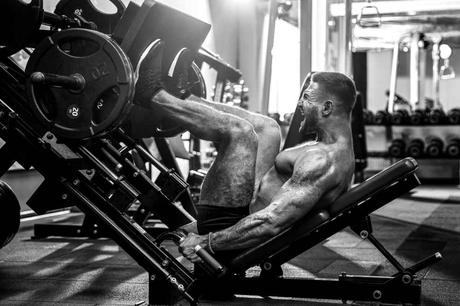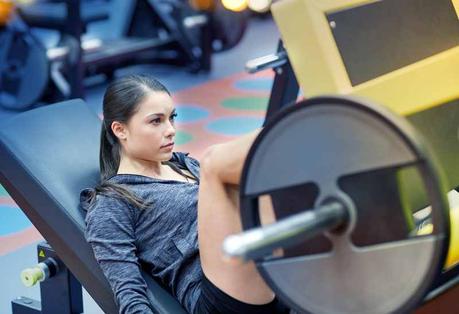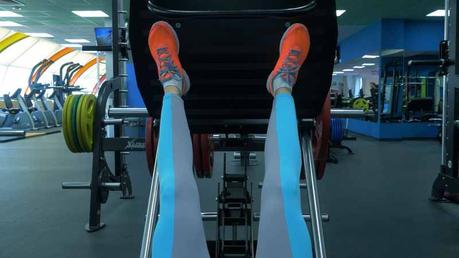Conquer leg day, and grow a stronger, more muscular lower body with this definitive guide to how to leg press like a champ.

The leg press is one of the BEST exercises you can do to safely max out the amount of weight you lift.
With squats and lunges, all the weight resting on your upper body means a higher risk of back strain.
But when you are hitting the leg press machine, there is no direct weight-bearing, so it’s all on your legs to do the pressing—ergo, an effective and safe exercise!
But did you know there’s a WRONG way to leg press?
Yes, it’s absolutely true. Doing the leg press incorrectly can:
- Decrease its effectiveness
- Increase change of knee injuries
- Risk lower back strain
Below, I’m going to show you how to do the leg press like a BOSS—i.e., the “right” way.
I’ll walk you through not only the proper form to follow, but also show you some of the most common mistakes newbies make when leg-pressing.
Read through this entire post and take to heart everything I’m about to share, and I guarantee you’ll master the leg press next time—and every time—you hit leg day at the gym.
Let’s jump right in and cover how to do the almighty leg press!
The Leg Press – Overview
The leg press is a closed-chain exercise, and even though it gets some flack from the Bro-Science crowd, there are some excellent benefits to the leg press.






As you can see, there are a lot of pretty great reasons to incorporate leg presses into your lower body workout routines.
Once you master the form (which I’ll share below), you’ll find it’s a highly effective and very safe leg day exercise.

How to Do the Leg Press Like a Boss (Step by Step)
Step 1: Sit or Lie Down
Horizontal leg press machines use an upright seat and a platform directly in front of you. Vertical and 45-degree leg presses use a seat that you lie down on, with the platform at a 45 or 90-degree angle from your position.
Whichever machine you use, the first step is to “assume” the position.
Proper leg press form means making sure your back is pressed firmly against the seat, your spine straight, and your posture upright.
Step 2: Place Your Feet
The standard foot placement is about hip-width apart, right on the center of the platform. However, if you want to change the focus of the exercise, you can change the placement of your feet.
For example:
- Slide your feet toward the lower edge of the platform to max out quads focus
- Slide your feet up toward the higher edge of the platform to target your hamstrings and glutes
- Slide your feet outward to work your hip adductors and the muscles protecting your knee
Whatever foot position you choose, make sure your heels are pressed flat against the platform.
Some trainers and expert lifters prefer to do leg presses barefoot, encouraging more natural movement in the feet.
Step 3: Raise the Platform
Before you start, the platform will be resting on the machine’s supports. When you’re ready to get working, push the platform up off the supports and use your leg muscles to support it.
You’ll probably need to turn the handles to move the supports out from beneath the platform.
Time to get working!
Step 4: Lower the Platform
Inhale through your nose as you lower the platform toward you. Keep your movement controlled—it should take you about 2 seconds to lower it toward you.
You’ll feel your hips shift slightly as you approach the lowest point of the movement, and you need to stop lowering the weight before your butt lifts off the seat. Your butt should always stay firmly planted; that way, your lower back is never engaged, but the focus is entirely on your legs.

Stop lowering just before your heels lose contact with the platform. Keeping your heels solidly in contact with the platform ensures you can engage the full power of your legs when it comes time to press up.
Step 5: Press Up
Now for the moment of truth!
Squeeze your abdominal muscles to help you push upward, driving through both the balls and heels of your feet. Exhale through your mouth as you extend your legs, pressing the weight upward.
Keep extending until just before you reach full extension, then stop with your knees slightly bent.
You never want to lock out your knees. Instead, use your quad muscles to support the weight at the peak of the press.
Pause for a 1-count at the peak of the press, then inhale and lower slowly once more.
Step 6: Repeat as Desired
The number of reps and sets you do will depend entirely on your ultimate goals.
If leg presses are your only lower body exercise, you’ll want to do at least 8-12 sets per workout in order to effectively train your muscles to failure.
How Many Reps of Leg Press Should I Do to Build Muscle?
- To build raw power, work in the 3-6 rep range, using heavyweight.
- To build functional strength, work in the 8-12 rep range, using moderately heavy weight.
- To build endurance, work in the 15-25 rep range, using lighter weight.
However, if you’re going to mix in other movements—such as lunges, squats, or hack squats—then do those other exercises first and finish off your Leg Day workout with 3-4 sets of leg presses, training to absolute failure.
Biggest Mistakes on the Leg Press Machine
Mistake 1: Raising Your Butt
This is a common mistake made by newbies who haven’t yet mastered the proper form. At the lowest point of the press, when your knees are bent, your butt tends to lift slightly off the seat and your lower back rounds.
When this happens, you’ve either:
- Set the angle of the seat too sharp (fix this by adjusting the seat)
- Lowered too far (you’ll feel it in your knees and hips—fix this by stopping once your legs crack the 90-degree angle)
Mistake 2: Losing Heel Contact
It’s not uncommon for people to have mobility limitations in their lower body, such as stiff knees, tight hips, or inflexible ankles.
All of these limitations can interfere with a full range of motion. The joints try to compensate, and for leg presses, it’s usually your ankles that do the most compensation.
You’ll feel your heels break contact with the platform because your knees, hips, or ankles don’t have sufficient flexibility to bend fully.
The key to fixing this is to stop lowering the weight just before your heels lose contact. That allows you to work through your full current range of motion safely and effectively.
But the more you leg press, the more your joints will adapt to the movement, so the more your range of motion will increase.
Mistake 3: Gripping Your Knees
Your hands should only grip your knees if you’re spotting yourself, lending a hand to push that extra-heavy weight up for one final set. Otherwise, grip the assist handles next to the bench.
Mistake 4: Overloading the Machine
Lifting too much weight is never a good idea. When your muscles are overloaded, your body tries to compensate by engaging the bones and joints. This leads to a higher risk of injury and compromises your form.
Not sure how much weight to start with? Start off light for your first set of 10 reps, then gradually increase until you struggle to complete a set of 8 reps.
That will tell you how much is just the right amount of weight to train to muscle failure without overloading and risking strain.
Mistake 5: Locking Your Knees
NEVER lock your knees at the top of the press!
When you lock your knees, you disengage the muscles completely, and the weight rests entirely on your bones and joints. Your risk of knee injury rises exponentially when you lock your knees.
Instead, stop pressing just before your legs are fully extended. That way, you can’t lock your knees, and your legs get an extra “bonus” workout supporting the weight at the peak of the press.
Mistake 6: Letting Your Knees Flare Out
People with hip mobility limitations will often struggle to lower fully. Their hips feel tight, so instead of risking injury, their body instinctively compensates by flaring out their knees.
You’ll recognize it immediately when it happens: during the lowest portions of the press, your hips will rotate to let your knees flare outward.
Do not let this happen.
Keep your knees in line with your legs throughout the entire movement. If your hips feel tight, adjust your foot placement slightly, or shift your toes inward or outward. Spend some time after your leg press workout to stretch and loosen up your hips to increase mobility overall.
How to Do the Leg Press – FAQs
Is leg press good for beginners?
Leg press is EXCELLENT for beginners because of A) how easy it is, and B) how safe it is.
It’s one of the easiest lower body exercises to master, because it’s only engaging your legs and not your lower back or upper body. You’ll find that just a few days of practice is all it takes to get the form right.
Plus, because there’s no weight directly loaded on your body, it’s safe enough even for those who have poor muscle tone or limited mobility.
What does the leg press work?
The muscles worked in the leg press begin with the quadriceps, the group of four leg muscles on the thighs (front). However, it also works the hamstrings (backs of your legs), glutes (butt muscles), and calves (lower legs).
Can leg press replace squats?
They absolutely can! Leg presses and squats both target the same muscles.
However, a better question might be “SHOULD leg press replace squats?” The answer to that is: no.
Leg presses and squats work the body in similar but slightly different ways. If you only did leg presses, you’d be limiting yourself to training in a single range of motion.
For more functional, versatile fitness, it’s better to work in multiple ranges of motion and multiple positions—i.e. mixing up a variety of lower body movements, including both leg presses and squats in the same training session.
The Bottom Line
Leg presses are a BEAST of a workout, one that allows you to max out weight safely and remove your lower back from the equation. This helps to reduce injury risk and increase focus on your leg muscles.
All in all, it’s a truly excellent lower body movement that you’d do well to include in your leg day. Thanks to the advice above, you’ll now know how to do it PROPERLY!
More Leg Press Guides
As you can probably guess, we are big fans of the leg press and the leg press machine around these parts! We’ve covered the exercise (and the machine used for it) extensively on this site.
Here are some more resources to help you continue along your journey to becoming a leg pressing dynamo!

6 Best Leg Press Alternatives for Monster Leg Muscles. Looking to mix up your leg training? Here are the six best leg press alternatives for conquering leg day.
7 Benefits of the Leg Press (and How to Do It Like a Champ). The leg press is a killer way to develop stronger and more muscular legs. Here are 7 reasons to hit the leg press machine on your next leg day.
6 Tips for Targeting Your Glutes on Leg Press. The leg press is an underrated way to develop stronger glutes. Here are six tips on how to optimize the exercise so that you are primarily targeting the glutes.
